To clean your stainless steel water bottle, try these simple methods: Make a baking soda paste by mixing it with water, scrub, and rinse. Dilute vinegar for a soak, add essential oils, and rinse. Use lemon and salt scrub for a citrusy clean. Create a hydrogen peroxide solution for sterilization. Prevent bacterial growth with proper drying. Avoid dishwashers for longevity. Remove odors with baking soda. Maintain shine with water and vinegar polishing. Store in a cool, dry spot. Clean after every use for durability. Explore more tips for keeping your bottle fresh and lasting longer.
Gather Necessary Supplies
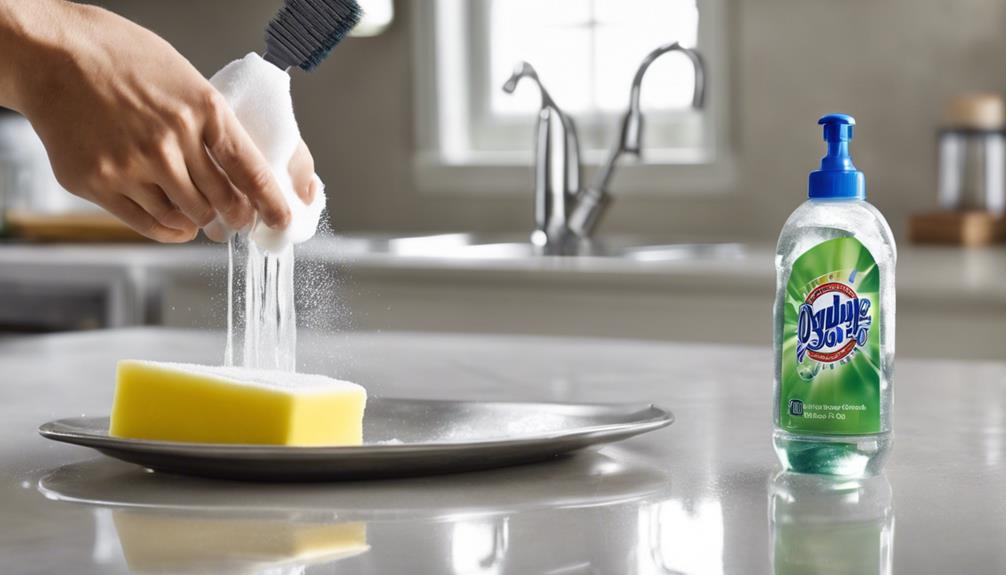
To begin cleaning your stainless steel water bottle effectively, gather the necessary supplies. Proper supplies organization is key to streamlining the cleaning process and ensuring you have everything you need at hand. Start by designating a specific area where you can keep all your cleaning supplies together. This helps in creating a cleaning schedule and makes it easier to locate items when needed.
When organizing your supplies, consider having a dedicated basket or caddy to hold items such as a bottle brush, dish soap, vinegar, and a microfiber cloth. This not only keeps everything in one place but also prevents clutter and saves time when it's cleaning day.
Additionally, having a set cleaning schedule ensures that you regularly maintain your stainless steel water bottle, preventing any build-up or odors.
Method 1: Baking Soda Paste
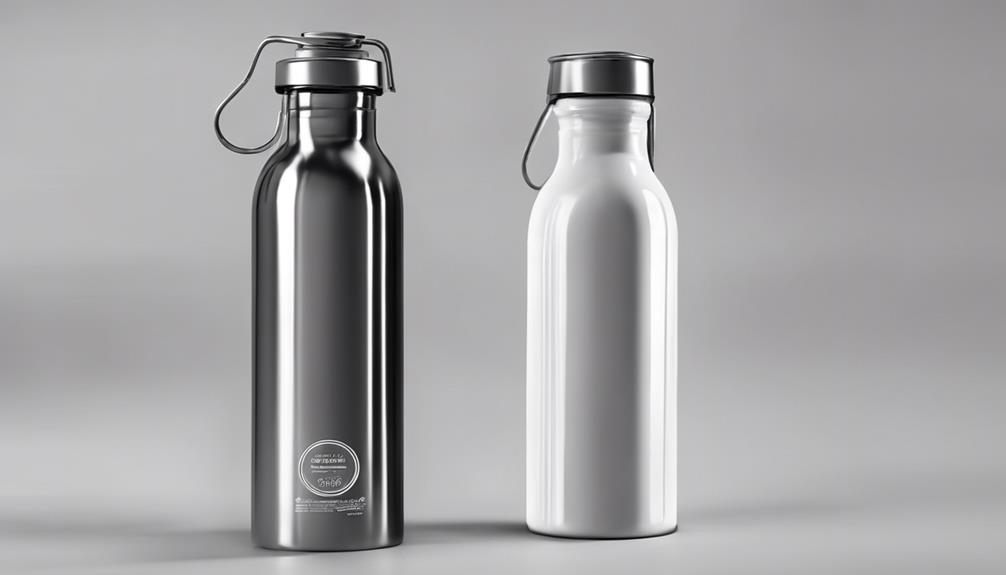
Start by creating a paste using baking soda for effectively cleaning your stainless steel water bottle. Baking soda is a natural cleaning agent that's gentle yet effective on stainless steel surfaces. Here's how to use this method:
- Mix Baking Soda and Water: Combine baking soda with a small amount of water in a bowl to create a thick paste.
- Apply Paste to Bottle: Use a soft cloth or sponge to apply the baking soda paste to the inside of your water bottle.
- Scrub and Rinse: Gently scrub the interior of the bottle with the paste, focusing on any areas with stains or odors. Once done, rinse the bottle thoroughly with water.
This eco-friendly alternative not only helps maintain your stainless steel bottle but also eliminates the need for harsh chemicals. By opting for natural cleaning methods like this DIY solution, you can ensure the longevity and cleanliness of your stainless steel water bottle while promoting sustainable stainless steel care.
Method 2: Vinegar Soak
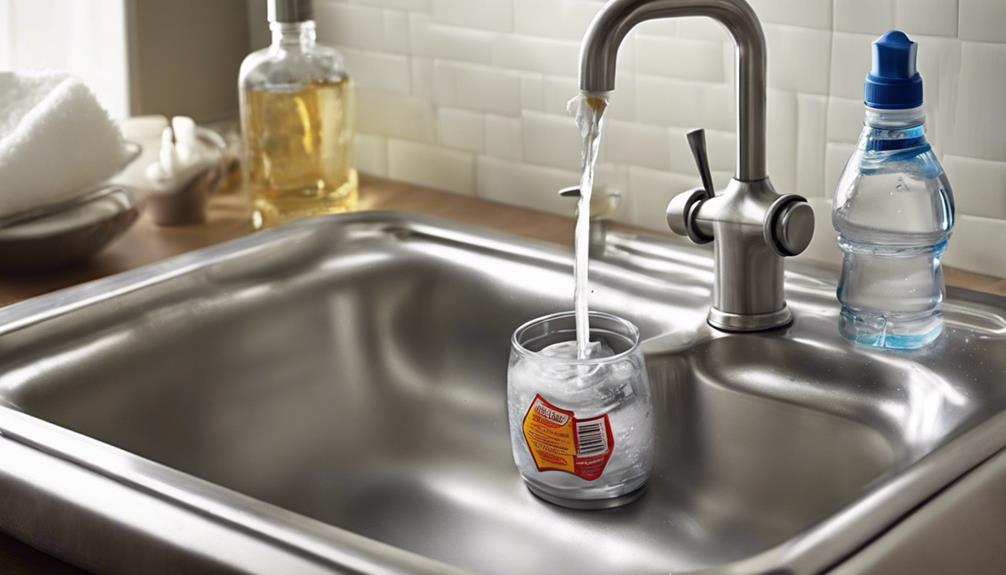
To start the vinegar soak method, dilute white vinegar with water in a 1:1 ratio.
Submerge your stainless steel water bottle in the vinegar solution and let it soak for at least 30 minutes.
After soaking, rinse the bottle thoroughly with water to remove any vinegar residue.
Vinegar Dilution Process
Begin by preparing a vinegar solution for soaking your stainless steel water bottle. Vinegar, known for its antibacterial properties, can effectively remove odors and stains from your bottle.
Follow these steps for a successful vinegar dilution process:
- Measure Vinegar: Dilute white vinegar with an equal amount of water to create a potent cleaning solution.
- Add Essential Oils (Optional): Enhance the cleaning power and leave a pleasant scent by mixing in a few drops of essential oils like lavender or tea tree.
- Soak Bottle: Submerge your stainless steel water bottle in the vinegar solution for at least 30 minutes to allow the mixture to break down any residue effectively.
Soaking and Rinsing Technique
For a thorough cleaning process, consider employing the vinegar soak method to effectively remove stubborn residues from your stainless steel water bottle. Start by filling your bottle with a mixture of equal parts white vinegar and water.
Let it soak for at least 30 minutes to break down any built-up grime. The soaking duration can vary depending on the level of residue, but 30 minutes is a good starting point.
After soaking, use a bottle brush or sponge to scrub the interior of the bottle, focusing on any areas with remaining residue. The scrubbing techniques should be gentle yet thorough to ensure all residues are lifted off.
Rinse the bottle thoroughly with warm water to remove the vinegar solution and loosened grime. Make sure to use warm water as it helps to remove any remaining residue effectively.
Method 3: Lemon and Salt Scrub
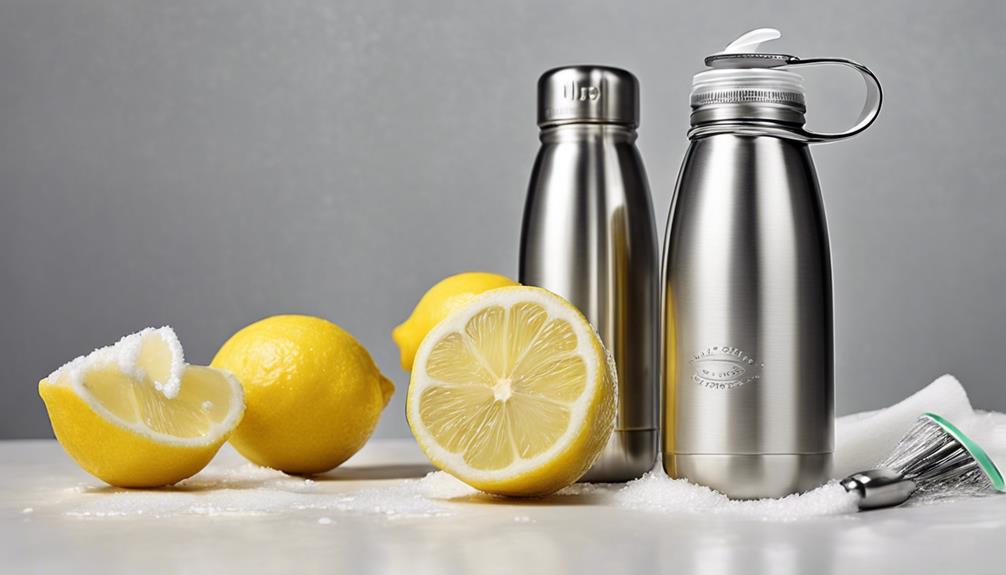
You can effectively clean your stainless steel water bottle by using a lemon and salt scrub. This method combines the natural cleaning properties of lemon and the abrasive power of salt to remove stains and odors from your bottle. Follow these steps to get your bottle sparkling clean:
- Citrus Freshness: The acidic nature of lemons helps break down grime and bacteria, leaving your bottle smelling fresh and clean.
- Natural Cleaning: Lemon is a natural antibacterial agent, making it a safe and eco-friendly option for cleaning your water bottle.
- Abrasive Salt: Salt acts as a gentle abrasive that helps scrub away tough stains without damaging the stainless steel surface.
To use this method, cut a lemon in half and squeeze the juice into your bottle. Add a tablespoon of salt and use the lemon rind to scrub the interior of the bottle. Let it sit for a few minutes, then rinse thoroughly. Enjoy the citrus-fresh scent and the clean, sparkling finish of your stainless steel water bottle.
Method 4: Hydrogen Peroxide Solution
Consider utilizing a hydrogen peroxide solution as an effective method for cleaning your stainless steel water bottle. Hydrogen peroxide is known for its peroxide effectiveness in killing bacteria and viruses, making it a powerful cleaning agent. To sterilize your bottle, create a solution of equal parts hydrogen peroxide and water.
Begin by rinsing your stainless steel water bottle with warm water to remove any loose debris. Then, pour the hydrogen peroxide solution into the bottle, ensuring it reaches all areas. Let the solution sit in the bottle for about 10-15 minutes to allow it to effectively kill any germs present.
After the solution has had time to work its magic, thoroughly rinse the bottle with water to remove any remaining hydrogen peroxide. Ensure the bottle is completely dry before using it again.
This method not only helps in peroxide effectiveness but also aids in bottle sterilization, leaving your stainless steel water bottle clean and safe for your next use.
Use of Bottle Brush
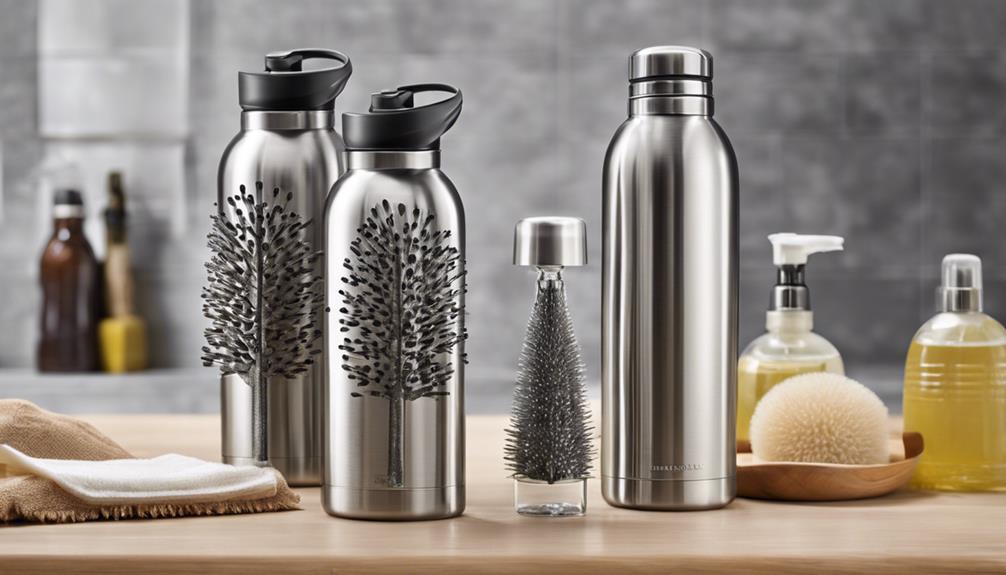
Utilize a bottle brush to effectively scrub the interior of your stainless steel water bottle, ensuring thorough cleaning of hard-to-reach areas. When cleaning your stainless steel water bottle, the bottle brush is a handy tool that can assist in maintaining cleanliness and hygiene. Here are some brush techniques and bottle cleaning tips to help you achieve a spotless bottle:
- Choose the Right Brush: Select a bottle brush with sturdy bristles that can effectively scrub away residue and bacteria without scratching the stainless steel surface.
- Scrub in Circular Motions: When using the bottle brush, employ circular motions to reach all areas inside the bottle and ensure a comprehensive clean.
- Rinse Thoroughly: After scrubbing the interior of the bottle with the brush, make sure to rinse it thoroughly with warm water to remove any remaining debris and soap residue effectively.
Importance of Air Drying
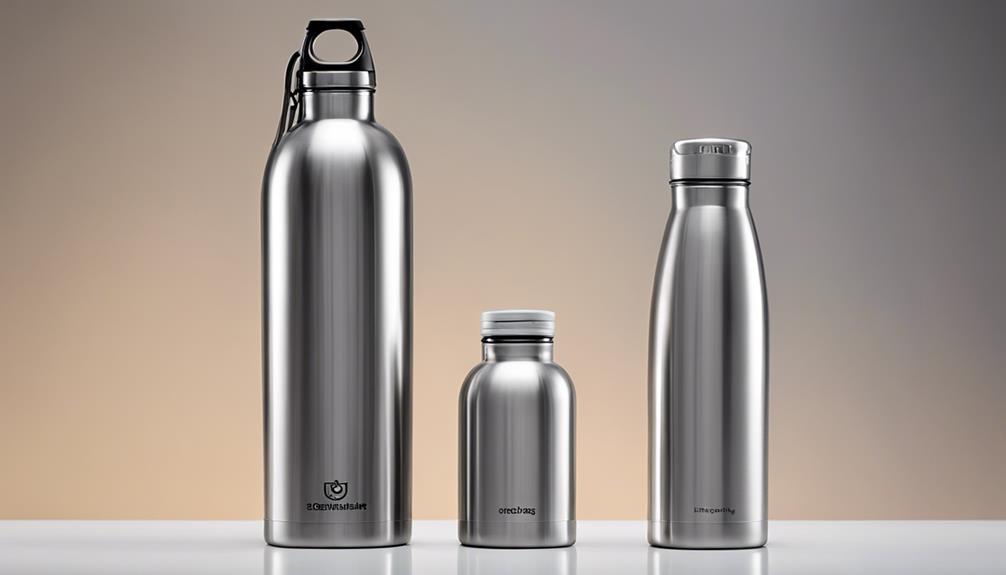
Air drying your stainless steel water bottle is crucial for preventing bacterial growth and maintaining its cleanliness. Properly drying your bottle ensures that no moisture is trapped, reducing the risk of mold formation.
Follow recommended air drying techniques to keep your bottle hygienic and in top condition.
Air Drying Benefits
Why is allowing your stainless steel water bottle to air dry after cleaning crucial for maintaining its cleanliness and longevity?
Air drying benefits aren't only essential for hygiene but also eco-friendly. Here are three reasons why you should air dry your stainless steel water bottle:
- Prevents Bacterial Growth: Air drying your bottle helps to eliminate moisture, creating an inhospitable environment for bacteria to thrive. This reduces the risk of contamination and keeps your water bottle hygienic.
- Preserves Material Quality: By air drying your stainless steel water bottle, you avoid potential damage that can be caused by towel drying, such as scratches or lint getting stuck. This helps maintain the quality and appearance of your bottle over time.
- Reduces Energy Consumption: Opting to air dry your water bottle instead of using energy-consuming methods like a dryer is an eco-friendly choice. It helps lower your carbon footprint and promotes sustainable practices.
Proper Drying Techniques
To ensure optimal cleanliness and longevity of your stainless steel water bottle, properly drying it after cleaning is essential. After washing your bottle with soap and water, it's crucial to thoroughly dry it to prevent the growth of bacteria.
Towel drying is a common method, but it's essential to use a clean, dry towel to avoid introducing any contaminants. Pat the inside and outside of the bottle until it's completely dry. However, air drying is the most effective technique as it allows for natural evaporation without the risk of leftover lint or bacteria from towels.
When air drying your stainless steel water bottle, make sure to place it upside down on a drying rack or a clean dish towel in a well-ventilated area. This position allows any remaining water droplets to drain out completely.
Avoid storing your bottle while it's still wet, as moisture can lead to bacterial growth or even rusting over time. By following these proper drying techniques and storage tips, you can maintain the cleanliness and quality of your stainless steel water bottle for years to come.
Tips for Daily Maintenance
Consistently wiping down your stainless steel water bottle with a microfiber cloth can help prevent buildup and maintain its pristine appearance. Daily maintenance is key to ensuring the longevity and aesthetics of your bottle.
Here are some essential tips to keep your stainless steel water bottle in top condition:
- Preventing Rust: Avoid leaving your bottle in damp environments for extended periods as moisture can lead to rust formation.
- Avoiding Scratches: Be cautious when placing your bottle alongside other items, as rough surfaces can scratch the stainless steel exterior.
- Maintaining Shine: Regularly polish your water bottle with a mixture of water and vinegar to maintain its shiny finish.
Avoiding Dishwasher Pitfalls
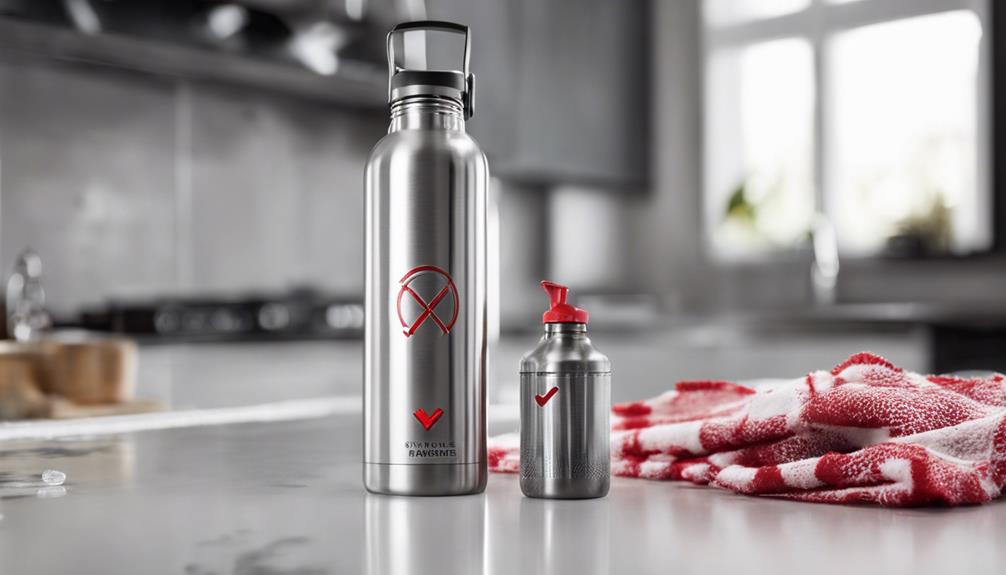
When it comes to cleaning your stainless steel water bottle, it's crucial to exercise caution with dishwashers. While they may seem convenient, dishwashers can damage the bottle's finish and insulation.
Opting for handwashing not only preserves the bottle's quality but also ensures a thorough clean every time.
Dishwasher Caution
Using a dishwasher to clean your stainless steel water bottle may lead to potential damage if not done correctly. Here are some key points to consider to ensure the safety of your water bottle and maintain its quality:
- Dishwasher safety: Always check the manufacturer's instructions to see if your stainless steel water bottle is dishwasher safe. Some bottles can withstand the high heat and agitation of a dishwasher, while others cannot.
- Proper drying methods: After the dishwasher cycle is complete, make sure to remove your water bottle promptly and thoroughly dry it. Leaving water droplets or moisture inside the bottle can lead to discoloration or even mold growth over time.
- Avoid harsh detergents: Some dishwasher detergents contain harsh chemicals that can corrode the stainless steel material of your water bottle. Opt for gentle, eco-friendly detergents to avoid damaging your bottle.
Handwashing Benefits
To maintain the quality and longevity of your stainless steel water bottle, handwashing offers numerous benefits over using a dishwasher. When you handwash your bottle, you ensure that it's cleaned thoroughly and that no residue or bacteria linger in hard-to-reach crevices that dishwashers mightn't effectively clean. This not only contributes to the health benefits of using a clean water bottle but also aligns with your hygiene practices.
Moreover, handwashing your stainless steel water bottle is a more sustainable option compared to using a dishwasher. By avoiding frequent dishwasher usage, you reduce the environmental impact caused by the energy and water consumption of dishwashers. Embracing handwashing as a cleaning method for your water bottle reflects your sustainability efforts and promotes eco-friendly practices in daily routines.
Removing Lingering Odors
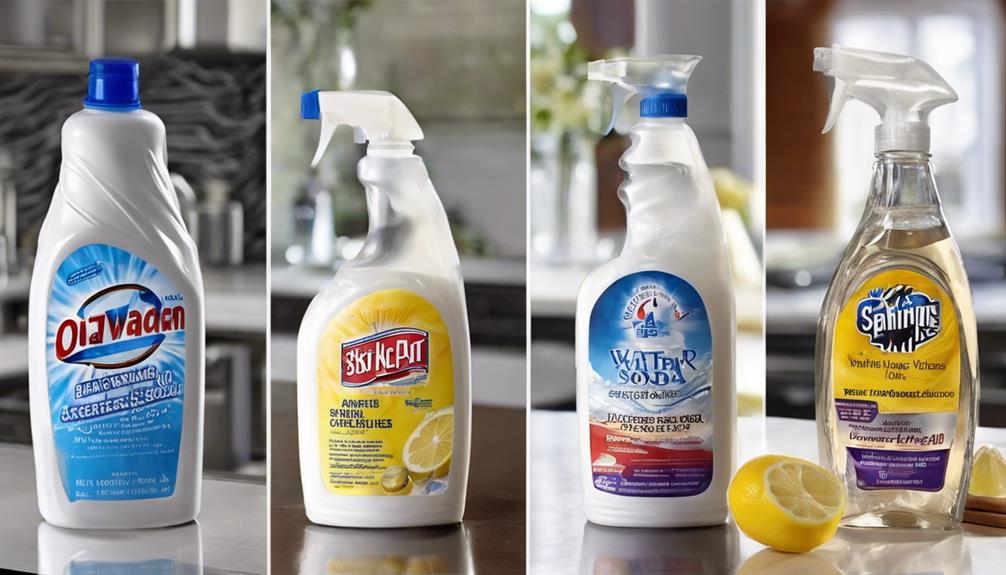
If you notice lingering odors in your stainless steel water bottle, a simple solution is to use baking soda to help eliminate them effectively. Baking soda is a natural remedy known for its odor-absorbing properties, making it an ideal choice for removing stubborn smells from your bottle.
Here are three methods to assist you in tackling those unpleasant odors:
- Baking Soda Paste: Create a paste using baking soda and water, apply it to the interior of your bottle, scrub gently, and let it sit for a few hours before rinsing thoroughly.
- Baking Soda Soak: Fill your bottle with a mixture of warm water and baking soda, let it soak overnight, then wash it out the next morning for a fresh-smelling result.
- Baking Soda and Vinegar Rinse: Combine baking soda and vinegar inside the bottle, allow it to fizz and sit for a few minutes, then rinse out the solution to remove odors effectively.
Final Tips for Longevity
For enhanced longevity of your stainless steel water bottle, proper maintenance and care are essential. To ensure your bottle lasts for years to come, consider the following final tips.
Firstly, proper storage is crucial. Store your stainless steel water bottle in a cool, dry place when not in use. Avoid exposing it to extreme temperatures or direct sunlight, as this can affect its quality over time.
Secondly, cleaning frequency plays a significant role in maintaining your bottle's longevity. Wash your bottle regularly, ideally after each use, to prevent bacteria growth and odors. Use gentle cleaning methods to avoid damaging the stainless steel material.
Consider the compatibility of materials when cleaning your bottle. Opt for cleaning solutions that are safe for stainless steel to prevent corrosion or damage. Additionally, explore eco-friendly cleaning options to reduce the environmental impact of your maintenance routine.
Frequently Asked Questions
Can I Use Bleach to Clean My Stainless Steel Water Bottle?
You should avoid using bleach to clean your stainless steel water bottle as it can be corrosive and unsafe. Instead, consider using alternative cleaning methods like vinegar and baking soda for a safer and effective cleaning solution.
Is It Safe to Use Essential Oils for Cleaning the Bottle?
Before diving into using essential oils for cleaning your stainless steel water bottle, consider potential safety concerns. Research alternatives like vinegar or baking soda to ensure both cleanliness and safety. Always prioritize your health.
Can I Use Abrasive Scrubbing Pads on Stainless Steel?
To clean stainless steel, avoid scratches by not using abrasive scrubbing pads. Instead, try alternative methods like baking soda or soft cloths. Keep your bottle shiny and scratch-free by following these gentle cleaning techniques.
How Often Should I Deep Clean My Water Bottle?
To maintain cleanliness and prevent bacteria growth in your water bottle, deep clean it every 1-2 weeks. Regular maintenance is crucial to avoid health risks. Stay vigilant and keep your bottle fresh!
Can I Use a Regular Sponge Instead of a Bottle Brush?
You can use a regular sponge as a bottle brush alternative for cleaning stainless steel water bottles. Ensure the sponge is non-abrasive to avoid scratching. Consider using cleaning techniques like hot water, soap, and vinegar for effective results.
Conclusion
Congratulations! You've now mastered the art of cleaning your stainless steel water bottle. Remember to follow these simple methods regularly to keep your bottle sparkling clean.
And for those stubborn odors, just remember to avoid the dishwasher pitfalls.
Who knew that keeping your water bottle clean could be so easy? Happy hydrating!

